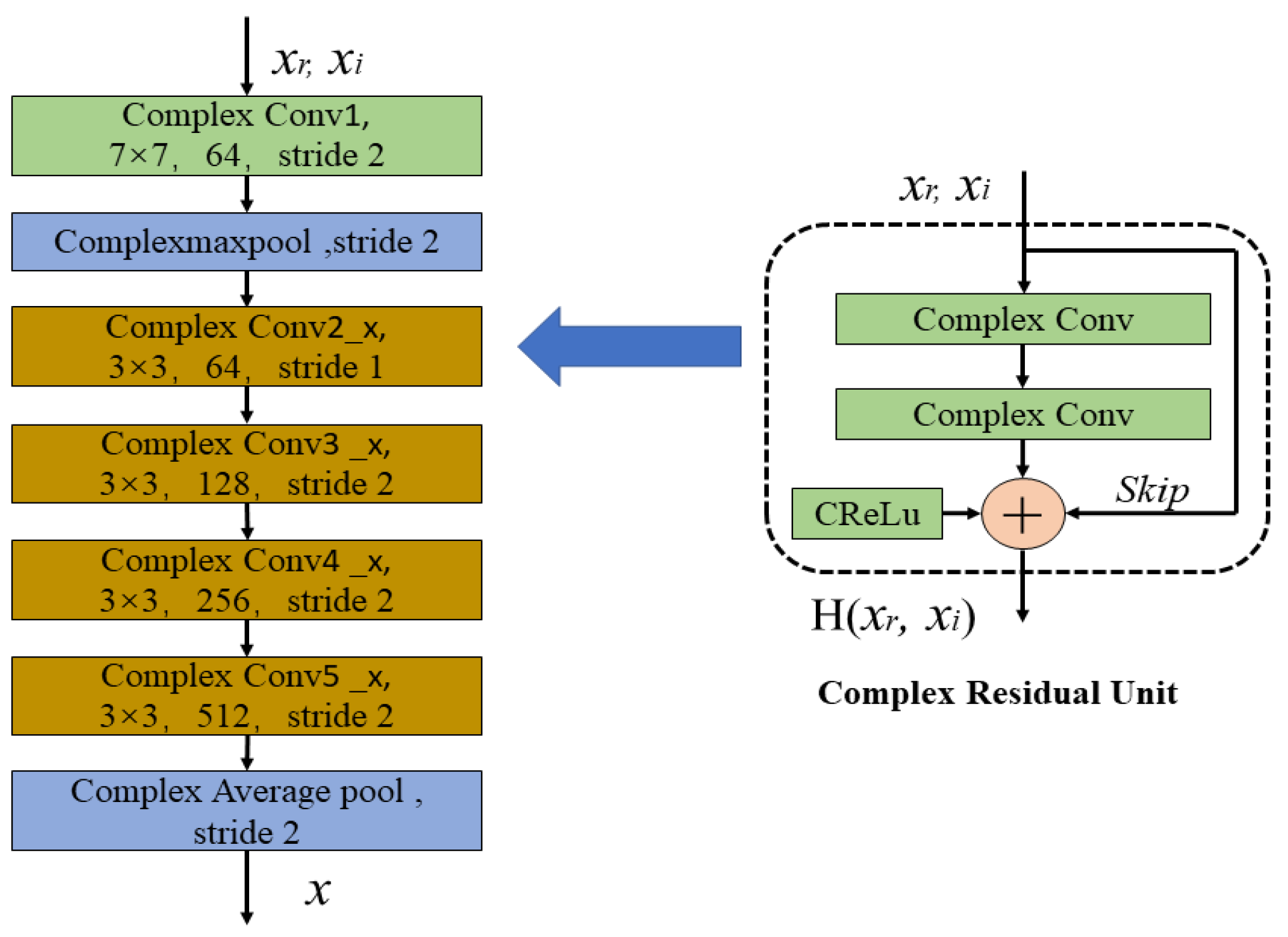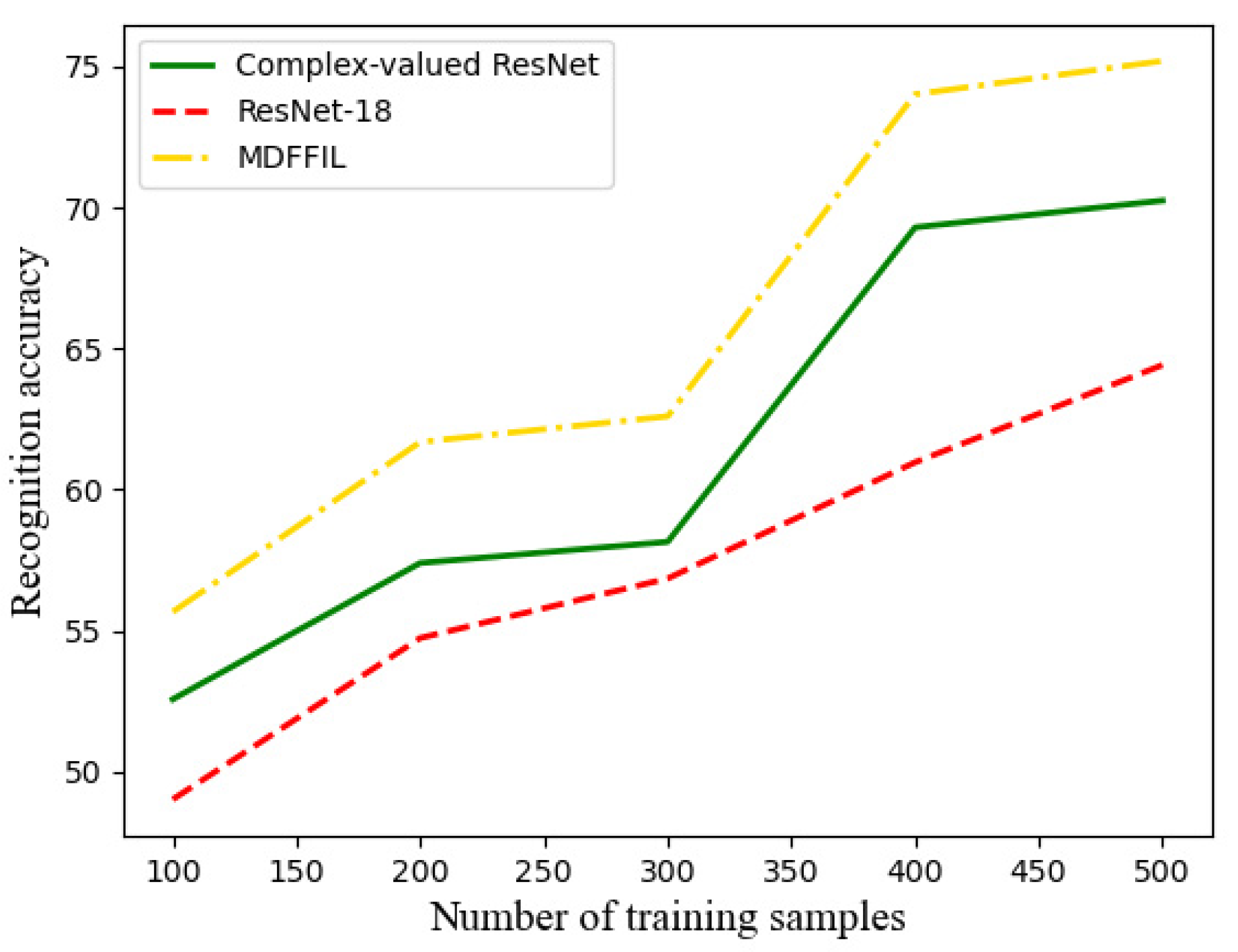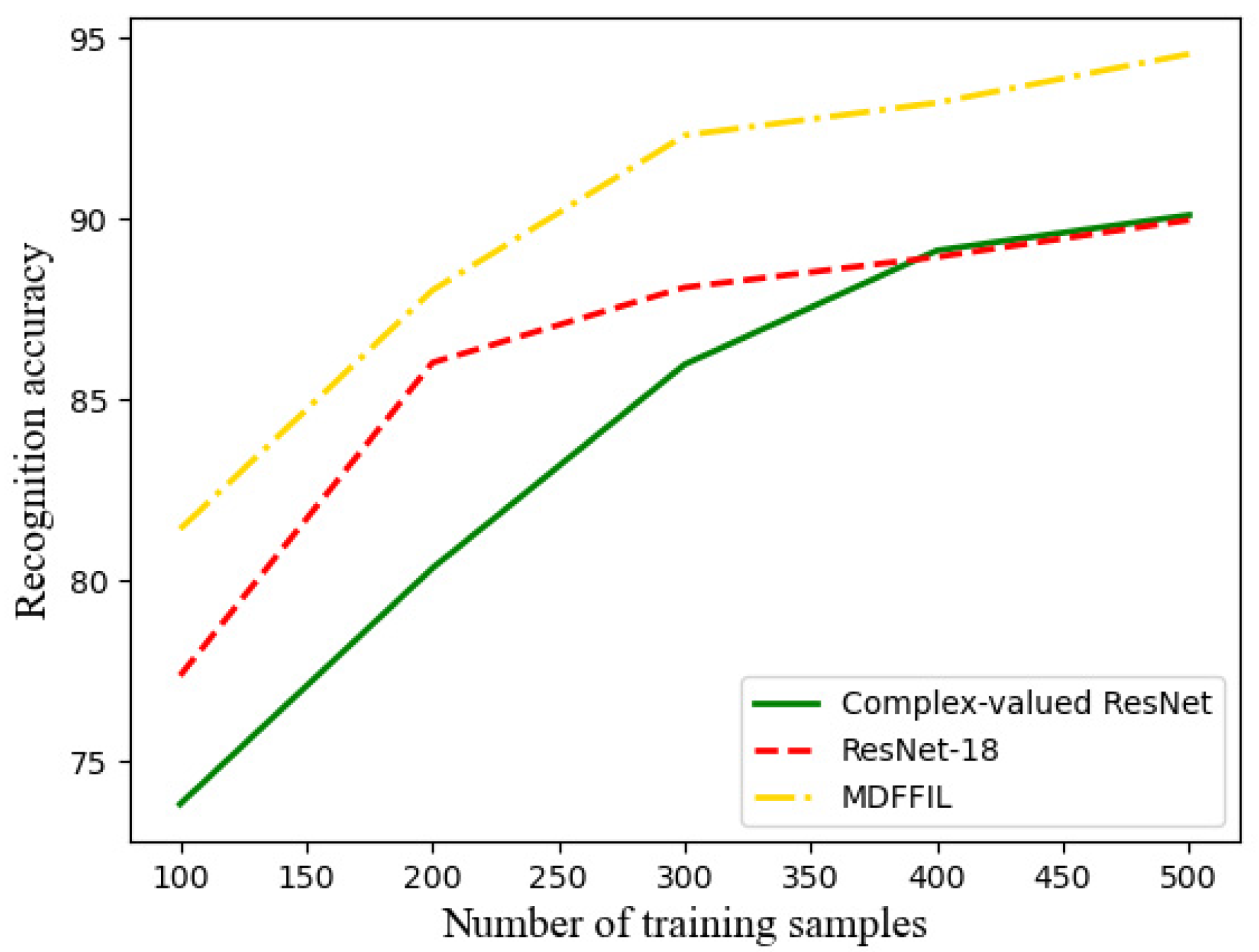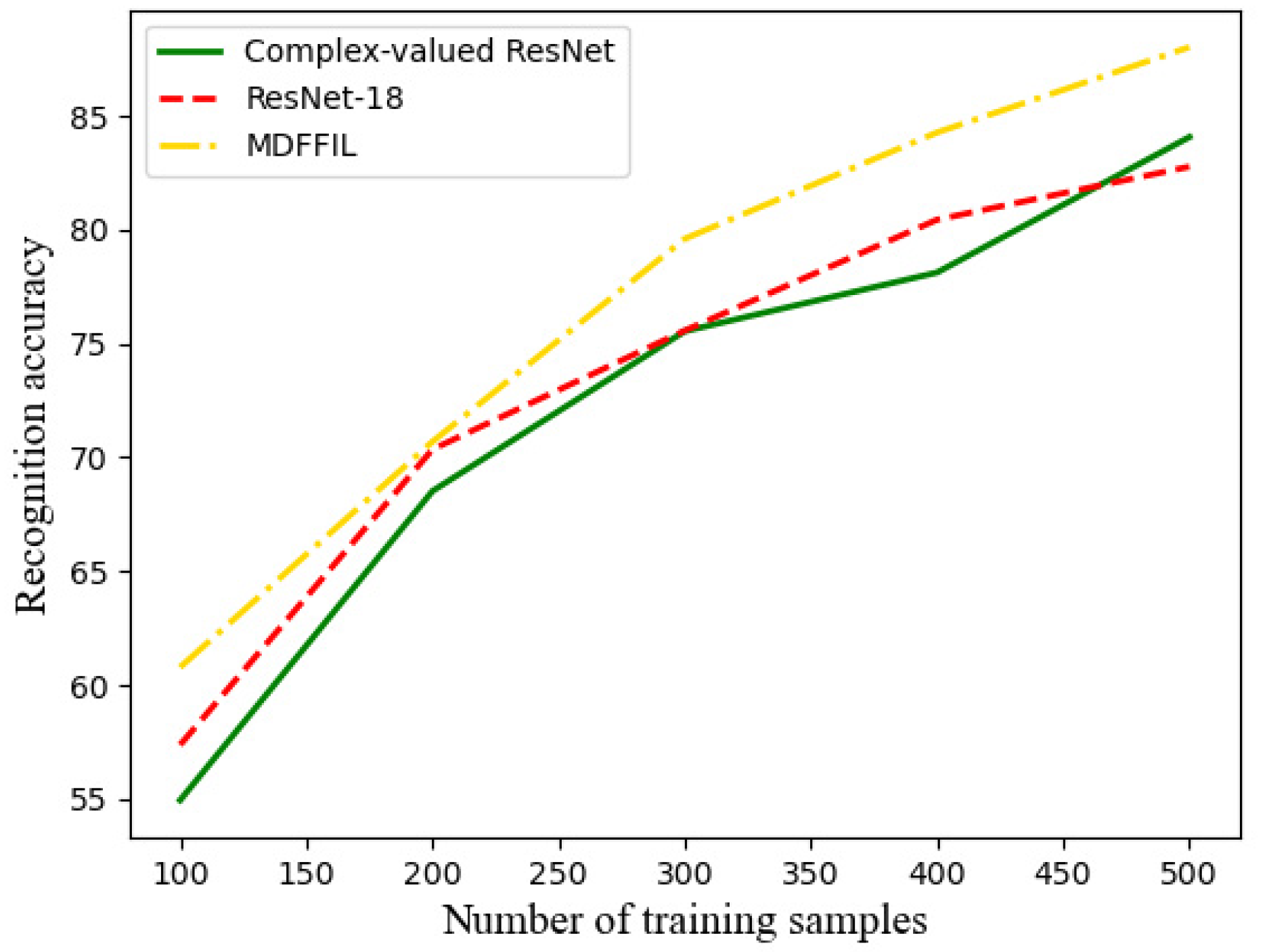Specific Emitter Identification Based on Multi-Domain Feature Fusion and Integrated Learning
Abstract
:1. Introduction
- (1)
- A symmetric feature extraction architecture is designed, which integrates the time domain and time–frequency variation domain features of limited data to enhance the utilization of the data.
- (2)
- An ensemble learning approach is proposed to make full use of the performance of residual networks and complex-valued residual networks.
- (3)
- The combination of intelligent learning and signal processing technology greatly improves the ability to recognize radiation sources under the condition of sparse labeled samples.
2. Background
2.1. Wavelet Transform
2.2. Residual Network
2.3. Complex-Valued Residual Network
- Complex-valued convolution layer:
- Complex-valued weight initialization method
- Complex-valued activation function
- Complex-valued normalization layer
3. Specific Emitter Identification Based on Integrated Learning
3.1. Algorithm Flow
3.1.1. Feature Extraction
- (1)
- Preprocess the samples of the original I/Q signal, discard the data of the transmission silent state, splice the processed data set according to 8192 sampling points, and then standardize each sample data to reduce the effect of transmitting power.
- (2)
- Set the number of scales in Continuous Wavelet Transform (CWT) to 101, and perform continuous wavelet transformation on each normalized signal to obtain a scale map. Therefore, the input size of each residual network is 8192 × 101.
- (3)
- Use the labeled time domain signal data to train the shallow complex-valued residual network model, use the time–frequency variation domain data to train the shallow residual network model, and then use the trained feature extraction network to extract the data features of the labeled signal and the signal to be identified.
3.1.2. Feature Fusion
- (4)
- The features extracted from the two shallow network models are considered as the real and imaginary inputs of the complex-valued neural network classifier to train the classification model.
- (5)
- Input the data features of the signal to be recognized into the trained classification model to obtain the final classification results.
3.2. Classifier Model Framework
3.3. Network Parameters and Comparative Experimental Settings
3.3.1. Network Model Setting
3.3.2. Baseline Methodology
4. Experimental Results and Discussion
4.1. Experimental Data
4.2. Experimental Result
5. Conclusions
Author Contributions
Funding
Institutional Review Board Statement
Informed Consent Statement
Data Availability Statement
Acknowledgments
Conflicts of Interest
References
- Talbot, K.; Duley, P.; Hyatt, M. Specific Emitter Identification and Verification. 2003. Available online: http://jmfriedt.org/phase_digital/03SS_KTalbot.pdf (accessed on 20 July 2021).
- Baldini, G.; Steri, G.; Giuliani, R. Identification of Wireless Devices from Their Physical Layer Radio-Frequency Fingerprints. In Encyclopedia of Information Science and Technology, 4th ed.; IGI Global: Hershey, PA, USA, 2019; pp. 937–949. [Google Scholar]
- Spezio, A.E. Electronic warfare systems. IEEE Trans. Microw. Theory Tech. 2002, 50, 633–644. [Google Scholar] [CrossRef]
- Ureten, O.; Serinken, N. Wireless security through RF fingerprinting. Electr. Comput. Eng. Can. J. 2007, 32, 27–33. [Google Scholar] [CrossRef]
- Rehman, S.; Sowerby, K.; Coghill, C. Radio-frequency fingerprinting for mitigating primary user emulation attack in low-end cognitive radios. Commun. IET 2014, 8, 1274–1284. [Google Scholar] [CrossRef]
- Serinken, N.; Üreten, O. Generalised dimension characterisation of radio transmitter turn-on transients. Electron. Lett. 2000, 36, 1064–1066. [Google Scholar] [CrossRef]
- Wu, L.; Zhao, Y.; Wang, Z.; Abdalla, F.Y.O.; Ren, G. Specific emitter identification using fractal features based on box-counting dimension and variance dimension. In Proceedings of the 2017 IEEE International Symposium on Signal Processing and Information Technology (ISSPIT), Bilbao, Spain, 18–20 December 2017; pp. 226–231. [Google Scholar]
- Huang, G.; Yuan, Y.; Wang, X.; Huang, Z. Specific Emitter Identification Based on Nonlinear Dynamical Characteristics. Can. J. Electr. Comput. Eng. 2016, 39, 34–41. [Google Scholar] [CrossRef]
- Lopez-Risueno, G.; Grajal, J.; Sanz-Osorio, A. Digital channelized receiver based on time-frequency analysis for signal interception. IEEE Trans. Aerosp. Electron. Syst. 2005, 41, 879–898. [Google Scholar] [CrossRef]
- Bertoncini, C.; Rudd, K.; Nousain, B.; Hinders, M. Wavelet Fingerprinting of Radio-Frequency Identification (RFID) Tags. IEEE Trans. Ind. Electron. 2012, 59, 4843–4850. [Google Scholar] [CrossRef]
- Han, J.; Zhang, T.; Wang, H.H.; Ren, D.F. Communication emitter individual identification based on 3D-Hibert energy spectrum and multi-scale fractal features. Tongxin Xuebao/J. Commun. 2017, 38, 99–109. [Google Scholar] [CrossRef]
- Pan, Y.; Yang, S.; Peng, H.; Li, T.; Wang, W. Specific Emitter Identification Based on Deep Residual Networks. IEEE Access 2019, 7, 54425–54434. [Google Scholar] [CrossRef]
- Zhang, J.; Wang, F.; Dobre, O.A.; Zhong, Z. Specific Emitter Identification via Hilbert–Huang Transform in Single-Hop and Relaying Scenarios. IEEE Trans. Inf. Forensics Secur. 2016, 11, 1192–1205. [Google Scholar] [CrossRef]
- Han, J.; Zhang, T.; Ren, D.; Zheng, X. Communication emitter identification based on distribution of bispectrum amplitude and phase. IET Sci. Meas. Technol. 2017, 11, 1104–1112. [Google Scholar] [CrossRef]
- Ding, L.; Wang, S.; Wang, F.; Wei, Z. Specific Emitter Identification via Convolutional Neural Networks. IEEE Commun. Lett. 2018, 22, 2591–2594. [Google Scholar] [CrossRef]
- Dudczyk, J.; Kawalec, A. Specific emitter identification based on graphical representation of the distribution of radar signal parameters. Bull. Pol. Acad. Sci. Tech. Sci. 2015, 63. [Google Scholar] [CrossRef]
- Zhao, Y.; Wu, L.; Zhang, J.; Li, Y. Specific emitter identification using geometric features of frequency drift curve. Bull. Pol. Acad. Sciences. Tech. Sci. 2018, 66, 99–108. [Google Scholar]
- Rybak, U.; Dudczyk, J. A Geometrical Divide of Data Particle in Gravitational Classification of Moons and Circles Data Sets. Entropy 2020, 22, 16. [Google Scholar] [CrossRef] [PubMed]
- Robinson, J.; Kuzdeba, S.; Stankowicz, J.; Carmack, J. Dilated Causal Convolutional Model for RF Fingerprinting. In Proceeding of the 2020 10th Annual Computing and Communication Workshop and Conference (CCWC), Las Vegas, NV, USA, 6–8 January 2020. [Google Scholar] [CrossRef]
- Wong, L.J.; Headley, W.C.; Michaels, A.J. Specific Emitter Identification Using Convolutional Neural Network-based IQ Imbalance Estimators. IEEE Access 2019, 7, 33544–33555. [Google Scholar] [CrossRef]
- Merchant, K.; Revay, S.; Stantchev, G.; Nousain, B. Deep Learning for RF Device Fingerprinting in Cognitive Communication Networks. IEEE J. Sel. Top. Signal Process. 2018, 12, 160–167. [Google Scholar] [CrossRef]
- Sa, K.; Lang, D.; Wang, C.; Bai, Y. Specific Emitter Identification Techniques for the Internet of Things. IEEE Access 2019, 8, 1644–1652. [Google Scholar] [CrossRef]
- Wu, Q.; Feres, C.; Kuzmenko, D.; Zhi, D.; Yu, Z.; Liu, X.; Liu, X. Deep Learning Based RF Fingerprinting for Device Identification and Wireless Security. Electron. Lett. 2018, 54, 1405–1407. [Google Scholar] [CrossRef] [Green Version]
- Baldini, G.; Gentile, C.; Giuliani, R.; Steri, G. Comparison of techniques for radiometric identification based on deep convolutional neural networks. Electron. Lett. 2019, 55, 90–92. [Google Scholar] [CrossRef]
- He, K.; Zhang, X.; Ren, S.; Sun, J. Deep Residual Learning for Image Recognition. In Proceedings of the 2016 IEEE Conference on Computer Vision and Pattern Recognition (CVPR), Las Vegas, NV, USA, 27–30 June 2016; pp. 770–778. [Google Scholar]
- Trabelsi, C.; Bilaniuk, O.; Zhang, Y.; Serdyuk, D.; Subramanian, S.; Santos, J.; Mehri, S.; Rostamzadeh, N.; Bengio, Y.; Pal, C. Deep Complex Networks. arXiv 2017, arXiv:1705.09792. [Google Scholar]
- Qu, L.; Yang, J.; Liu, H.; Huang, K. A method for individual identification of communication radiation sources based on complex residual networks. Signal Process. 2021, 37, 95–103. [Google Scholar]






| Layer Name | Filter Size | Output Size |
|---|---|---|
| Conv1 | 7 × 7, 64, stride2 | 64 × 4096 × 51 |
| max pool | stride2 | 64 × 2048 × 26 |
| conv2_x | , stride 1 | 64 × 2048 × 26 |
| conv3_x | , stride 2 | 128 × 1024 × 13 |
| conv4_x | , stride 2 | 256 × 512 × 7 |
| conv5_x | , stride 2 | 512 × 256 × 4 |
| Average pool | 512 |
| Layer Name | Filter Size | Output Size | |
|---|---|---|---|
| Xr | Xi | ||
| 1 × 512 | 1 × 512 | ||
| Complex Conv1 | 7 × 7, 64, stride2 | 64 × 256 | 64 × 256 |
| Complex max pool | stride2 | 64 × 256 | 64 × 256 |
| Complex conv2_x | , stride 1 | 64 × 128 | 64 × 128 |
| Complex conv3_x | , stride 2 | 128 × 64 | 128 × 64 |
| Complex conv4_x | stride 2 | 256 × 32 | 256 × 32 |
| Complex Average pool | 256 | ||
| 8 | |||
| Model Settings | Parameter Value |
|---|---|
| epoch | 200 |
| Initial learning rate | 1 × 10−3 |
| Optimizer | Adam |
| Loss function | Cross Entropy |
| Signal Parameters | Parameter Value |
|---|---|
| Modulation | QPSK |
| Code rate | 256 Kbps |
| Sampling Rate | 50 MHz |
| Radio power | 0.125 W |
| Data Set | Parameter Value | |
|---|---|---|
| Signal carrier frequency | Operating mode | |
| I | 400 MHz | Voice transmission |
| II | 450–460 MHz | Voice transmission |
| III | 400 MHz | Digital transmission |
| IV | 450–460 MHz | Digital transmission |
Publisher’s Note: MDPI stays neutral with regard to jurisdictional claims in published maps and institutional affiliations. |
© 2021 by the authors. Licensee MDPI, Basel, Switzerland. This article is an open access article distributed under the terms and conditions of the Creative Commons Attribution (CC BY) license (https://creativecommons.org/licenses/by/4.0/).
Share and Cite
Qu, L.-Z.; Liu, H.; Huang, K.-J.; Yang, J.-A. Specific Emitter Identification Based on Multi-Domain Feature Fusion and Integrated Learning. Symmetry 2021, 13, 1481. https://doi.org/10.3390/sym13081481
Qu L-Z, Liu H, Huang K-J, Yang J-A. Specific Emitter Identification Based on Multi-Domain Feature Fusion and Integrated Learning. Symmetry. 2021; 13(8):1481. https://doi.org/10.3390/sym13081481
Chicago/Turabian StyleQu, Ling-Zhi, Hui Liu, Ke-Ju Huang, and Jun-An Yang. 2021. "Specific Emitter Identification Based on Multi-Domain Feature Fusion and Integrated Learning" Symmetry 13, no. 8: 1481. https://doi.org/10.3390/sym13081481
APA StyleQu, L.-Z., Liu, H., Huang, K.-J., & Yang, J.-A. (2021). Specific Emitter Identification Based on Multi-Domain Feature Fusion and Integrated Learning. Symmetry, 13(8), 1481. https://doi.org/10.3390/sym13081481






